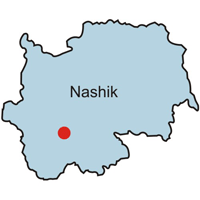 It is billed as the biggest gathering in the world. Every three years, millions of Hindus come together to bathe in a sacred river to wash away their sins.
It is billed as the biggest gathering in the world. Every three years, millions of Hindus come together to bathe in a sacred river to wash away their sins.
The Kumbh Mela festival, which rotates between four different holy sites in India, is taking place over two months this year in the city of Nashik in the state of Maharashtra. Its name, which means “Pitcher Festival,” comes from a Hindu myth about an epic battle in which gods and demons fought for nectar that would grant them immortality. The gods won — but during the ruckus, drops of the nectar spilled from the pitcher that was holding it, onto the four different locations which now host the festival.
Many of those attending are sadhus, Hindu holy men who have eschewed the modern world and material comforts for a life of penance and worship. They must cut ties with their homes and families, even performing their own funeral rites to become legally dead before living a nomadic life on the fringes of society.
Sadhus, estimated to number 4 to 5 million in India, command respect in Indian society and survive off donations offered in return for blessings and prayers. The sadhu represents the fourth and final stage of life before liberation from the cycle of reincarnation, which the holy men seek to achieve through their life of meditation and contemplation.
They are divided into two broad sects — those that worship Lord Shiva, the Shaiva sadhus, and those that worship the Lord Vishna, the Vaishnava sadhus. Within the shaiva sect, there is a subcategory who go naked as an additional form of penance — the naga sadhus.
For many sadhus, smoking marijuana is a fundamental part of their religious practice. They believe it brings them closer to Shiva, who according to Hindu mythology revived himself with cannabis leaves one particularly hot day, and thereafter made them a regular part of his diet.
Warning: This article contains photos of nude Indian holy men.
Naga sadhus shout religious slogans after taking the “Shahi Snan,” meaning “holy bath,” in a temple. Photo by Ahmer Khan.
Up to 100 million Hindu devotees gather every third year to take the Shahi Snan, in one of four different places in India. This year they’re bathing in the Godavari river in the city of Nashik in Maharashtra state. Photo by Ahmer Khan.
Sadhus often paint themselves with chalk or ash, which represents their death to the worldly life. They paint different colors on their bodies according to which god they are devoted to. Photo by Ahmer Khan.
Sadhus wear their hair in long dreadlocks, or “jata,” to represent their renunciation of civilisation and in honor of the god Shiva, whose long matted hair was said to contain his power. Photo by Ahmer Khan.
A sadhu prostrates towards a temple, as Hindu devotees take his blessing. Photo by Ahmer Khan.
Naga sadhus walk down the street after taking the Shahi Snan in the town of Trimbak. Photo by Ahmer Khan.
Devotees taking a holy bath. Photo by Ahmer Khan.
A sadhu sleeps before taking the Shahi Snan. Photo by Ahmer Khan.
The ash painted on sadhus’ faces represents their death to the worldly life. Photo by Ahmer Khan.
For many sadhus smoking pot is a fundamental part of their religious practice. They believe it helps them commune with the god Shiva. Photo by Ahmer Khan.
Sadhus of different sects surround one of their leaders at a holy temple during the Shahi Snan. Photo by Ahmer Khan.





